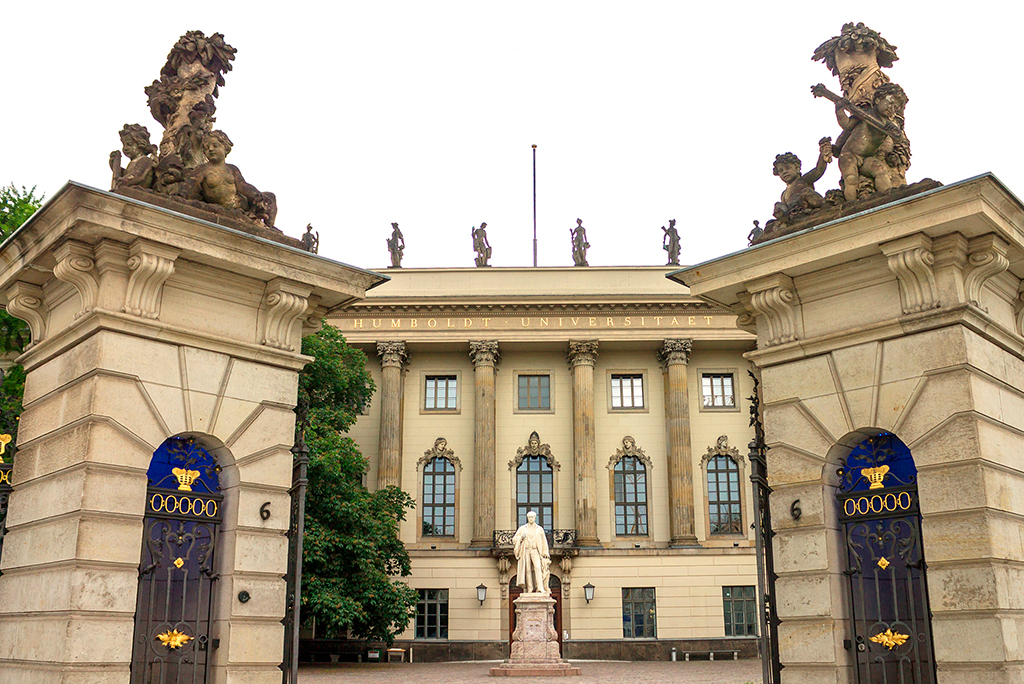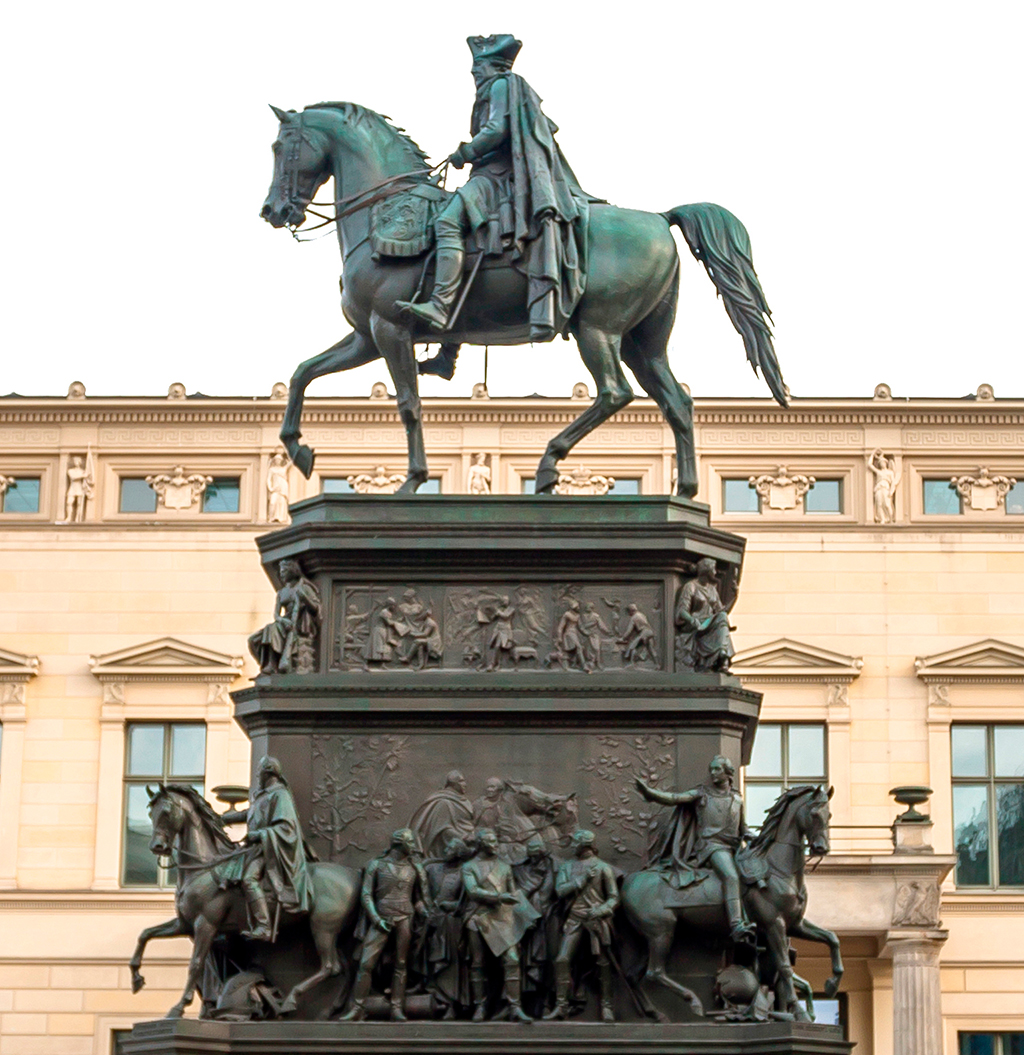“As long as the lime trees still blossom in Unter den Linden, Berlin will always be Berlin,” sang Marlene Dietrich about this magnificent avenue. The lime trees blossom more beautifully than ever and the street’s old buildings have been extensively restored. The Linden, once a royal bridle path linking the king’s town residence (the Stadtschloss) and Tiergarten, became Berlin’s most fashionable street in the 18th century, and was synonymous with the city that was then the capital of Prussia.
NEED TO KNOW
 Deutsches Historisches Museum: Zeughaus, Unter den Linden 2 • 030 20 30 40 • www.dhm.de • Open 10am–6pm daily • Admission charge
Deutsches Historisches Museum: Zeughaus, Unter den Linden 2 • 030 20 30 40 • www.dhm.de • Open 10am–6pm daily • Admission charge  Staatsoper: Unter den Linden 7 • 030 20 35 45 55 • www.staatsoper-berlin.de • Closed for renovation; until then, performances take place at the Schillertheater, Bismarckstr. 110
Staatsoper: Unter den Linden 7 • 030 20 35 45 55 • www.staatsoper-berlin.de • Closed for renovation; until then, performances take place at the Schillertheater, Bismarckstr. 110- Take a break at the Café im Deutschen Historischen Museum (in the Zeughaus) which can be accessed directly from the street.
1.Deutsches Historisches Museum
Germany’s largest history museum offers an overview of more than 1,000 years of German history. Housed in the Zeughaus, it is the oldest and architecturally the most interesting building on Unter den Linden (for further details see Deutsches Historisches Museum).

Deutsches Historisches Museum
2.Staatsoper Unter den Linden
The richly ornamented State Opera House is one of Germany’s most attractive. Neo-Classical in style, it was built by architect Georg Wenzeslaus von Knobelsdorff between 1741–3 as Europe’s first free-standing opera house, to plans devised by Frederick the Great himself.

Staatsoper Unter den Linden
3.St Hedwigskathedrale
Designed by von Knobelsdorff in 1740–2 and modelled on the Pantheon in Rome, this is the seat of Berlin’s Catholic archdiocese. It was commissioned by Frederick the Great to appease Berlin Catholics after the conquest of Silesia (for further details see St Hedwigskathedrale).

St Hedwigskathedrale
4.Humboldt-Universität
Berlin’s oldest and most highly regarded university was founded in 1890, on the initiative of Wilhelm von Humboldt. Twenty-nine Nobel Prize winners were educated here, including Albert Einstein.

Humboldt-Universität
5.Neue Wache
The central German memorial for all victims of war was created in 1816–8 by Karl Friedrich Schinkel. A reproduction of Käthe Kollwitz’s moving Pietà stands here.

Neue Wache
6.Opernpalais
The charming building next to the Staatsoper, built in 1733–7, was also known as the Kronprinzessinnenpalais and once served as a palace for the daughters of Friedrich Wilhelm III.
7.Russische Botschaft
The gigantic Russian Embassy, built in Stalinist “wedding-cake style”, was the first building to be erected on Unter den Linden after World War II.
8.Kronprinzenpalais
Originally created in 1669 as a private residence by Johann Arnold Nering, the building was remodelled in 1732–3 into a Neo-Classical palace by Philip Gerlach and was a residence for several Hohenzollern heirs. After World War I it became an art museum, before the East German government housed state visitors there. The German reunification agreement was signed here in August 1990. It now holds cultural events and exhibitions.
9.Bebelplatz
Originally named Opernplatz, this wide open space was designed by Georg W von Knobelsdorff as the focal point of his Forum Fridericianum. The elegant square was meant to introduce some of the splendour and glory of ancient Rome to the Prussian capital. In May 1933, it became the scene of the infamous Nazi book burning.
10.Frederick the Great’s Statue
One of Christian Daniel Rauch’s grandest sculptures, this equestrian statue shows “Old Fritz” (13.5 m/44 ft high) in his tricorn and coronation mantle (for further details see Frederick as Architect).

Frederick the Great’s Statue

Deutsches Historisches Museum
1.The Dying Warriors
The 22 reliefs by Andreas Schlüter, displayed on the walls of the courtyard rather than in one of the museum’s exhibitions, portray the horrors of war in an unusually immediate way.
2.Europe and Asia
This group of 18th century Meissen porcelain figures reflects the fascinating relationship between the two continents.
3.Steam Engine
A full-sized steam engine from the year 1847 marks the entrance to the exhibition on the Industrial Revolution.
4.Clothes from the Camps
Among the many exhibits here that illustrate the years under Nazi rule is the jacket of a concentration camp inmate – a chilling reminder of the Third Reich.
5.Martin Luther
Luther’s portrait, by Lucas Cranach the Elder, is the focal point of exhibition rooms devoted to the Reformation and Martin Luther.

Martin Luther by Lucas Cranach
6.Gloria Victis
The moving allegorical figure of Gloria Victis, created by the French sculptor Antonin Mercié, bears witness to the death of his friend during the final days of the Franco-Prussian War of 1870–71.

Gloria Victis by Antonin Mercié
7.Soldiers Plundering a House
This painting by Sebastian Vrancx, dating from around 1600, depicts a scene from the wars of religion that tore the Netherlands apart during the 16th century.
8.Saddle
A valuable saddle, dating from the middle of the 15th century, is decorated with elaborately carved plaques made of ivory.
9.The Berlin Wall
An original section of the Berlin Wall, together with the banners of a peaceful pro-unification demonstration in 1989, commemorates the fall of the Wall.
10.V2 Rocket
Exhibited in the section on Nazi Germany is a V2 rocket engine next to an 88-mm flak gun. The V2 missile was one of the Wunderwaffen (“wonder weapons”) used by German troops at the end of World War II.
ZEUGHAUS UNTER DEN LINDEN
Originally the royal arsenal, the Zeughaus was built in 1706 in the Baroque style according to plans by Johann Arnold Nering. It is an impressive structure, with the building surrounding a historical central courtyard that is protected by a modern glass cupola roof. Especially memorable are Baroque sculptor Andreas Schlüter’s figures of 22 dying warriors, lined up along the arcades in the courtyard. They portray vividly the horrors of war. Behind the main building stands a cone-shaped glass annex designed by the Chinese-born architect Ieoh Ming Pei in 2001 for special exhibitions and temporary shows. The permanent exhibition in the main historical building includes a collection entitled “Images and Testimonials of German History”. Highlighting the most significant periods and events in the history of the country, the displays include a surprising variety of exhibits dating back to the days of the early Medieval German Empire through the period of the Reformation and the Thirty Years’ War as well as the wars of Liberation and the failed Revolution of 1848, right up to the two World Wars and more recent events of the 20th century up to 1994.

Entry of Napoleon into Berlin, 27 October 1806 (1810) by Charles Meynier shows the victorious French at the Brandenburg Gate, Unter den Linden.
TOP 10 UNTER DEN LINDEN EVENTS
Elector Johann Georg has a bridle path built, linking the royal Stadtschloss and the Tiergarten
During the reign of the Great Elector, the road is planted with Linden (lime trees)
Frederick the Great has grand buildings erected
Napoleon and his troops march along Unter den Linden
The road turns into a grand boulevard
Unter den Linden and Friedrichstraße epitomize the world city
Troops celebrate Hitler’s victory
The avenue is razed to the ground
Revival of the boulevard
Demonstrations lead to the fall of the East German regime


